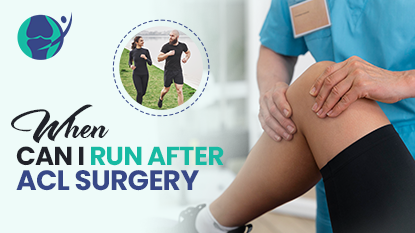One of the most frequent knee ailments, especially in athletes, is an anterior cruciate ligament (ACL) damage. ACL injuries can be disastrous, regardless of whether they result from an unforeseen twist or an accident related to sports. “When can I run after ACL surgery?” is one of the most frequent questions patients ask their doctors throughout the lengthy and unpredictable rehabilitation process following an ACL surgery.
- Understanding the phases of recovery and the benefits of rehabilitation will help you have a better notion of when running would be feasible and safe for your knee, even if each patient’s recovery period is different and contingent on a number of variables. We’ll go over the recuperation process, significant turning points, and crucial things to think about before you hit the road in this blog post.
- Understanding ACL Surgery and Recovery One of the important ligaments that stabilizes the knee is the ACL, which usually needs to be repaired or rebuilt surgically when damaged. To repair the damaged ligament, the procedure often entails removing a graft from your hamstring, patellar tendon, or occasionally a donor.
- Physical therapy, or rehabilitation, is essential after surgery to make sure your knee recovers properly and that you regain the strength, stability, and flexibility you need to start exercising again.
Table of Contents
ToggleRecovery from ACL surgery is usually divided into multiple stages:
- Phase I of Healing (0–6 Weeks)
- Range of Motion and Strengthening (6 Weeks to 3 Months)
- Proprioception and Advanced Strengthening (3–6 Months)
- Return to Full Activity and Sport (6 to 12 Months)
Important Elements That Impact Your Schedule
Prior to talking about when running is proper, it’s important to comprehend the different aspects that affect your recuperation.
1. The ACL Surgery Type
Your recovery may be impacted by different surgical techniques (such as a patellar tendon graft versus a hamstring graft). It’s possible that certain grafts are stronger and heal faster than others.
2. Your Level of Activity and Age
Athletes who were younger or more active in the past might be keen to get back to their pre-injury levels of fitness. However, your rate of recovery might be influenced by your age, level of fitness, and general health.
3. Compliance with Rehabilitation
The degree of dedication to physical therapy is one of the most crucial aspects of healing. You will regain the strength and range of motion you need to resume running sooner if you adhere to your rehabilitation program religiously.
4. Strength and Stability of the Knee
Your knee has to show enough strength and stability before you can start running. In order to stop additional harm, this is essential. Restoring your knee’s full function so it can endure the rigors of jogging is the aim.
5. Swelling and Pain
Your knee may not be completely prepared for high-impact exercises like running if you experience chronic discomfort and swelling. It’s crucial to hold off on moving forward until these problems have subsided.
Stages of recovery
- The first stage of healing (0–6 weeks): Reducing discomfort and swelling, safeguarding the new graft, and regaining basic knee mobility are the main goals during this initial stage. For the first few weeks, you will probably be on crutches, and you could be told to refrain from any weight-bearing activities that could strain your knee.
- Depending on the surgeon’s advice, patients can anticipate beginning with mild range-of-motion exercises and working their way up to non-weight-bearing activities like stationary cycling or swimming, even if running is absolutely not an option at this point.
Important Milestones:
- Complete knee extension, or the capacity to fully straighten the leg
- minimal to nonexistent edema
- Significantly lowering pain levels
Range of Motion and Strengthening (6 Weeks to 3 Months): Many patients can resume mild strengthening exercises to regain knee muscle function by the end of the first month. Through a variety of exercises, this phase focuses on strengthening the quadriceps and hamstrings, restoring knee flexibility, and boosting stability. You may now begin to walk without the use of crutches or other assistive technology. To maintain your cardiovascular fitness without overtaxing your knee, low-impact activities like swimming and cycling are frequently advised.
Although it’s still unsafe to run at this point, it’s crucial to focus on strengthening your knee muscles and enhancing your balance.
Important Milestones:
- enhancing calf, hamstring, and quadriceps strength
- Practicing proprioception (body awareness) and balance
- Reaching nearly complete knee range of motion
- Beginning stationary cycling and other mild aerobic exercises
Proprioception and Advanced Strengthening (3–6 Months): Patients should now be able to practice a variety of strengthening activities, like leg presses, lunges, and squats, to increase the stability of their knees. The goal is to improve neuromuscular control, strength, and endurance. Additionally, you will do functional motions that are similar to what you might do while jogging or playing sports.
You might begin with jumping exercises and agility drills to improve stability and proprioception. Around the four to six month mark, running may be resumed, albeit at a reduced intensity. At this point, a run-walk strategy is usually advised, which progressively increases the amount of time spent running and decreases the amount of time spent walking.
Important Milestones:
- Capacity to do plyometric exercises and agility drills
- enhanced proprioception and knee control
- Begin a run-walk program and progressively increase the level of difficulty.
- Return to low-impact activities like cycling and ellipticals.
Return to Full Activity and Sport (6 to 12 Months): Most patients are cleared to progressively resume full activity, including jogging, by the 6-month mark. But it is important that your knee is completely stable and that your knee muscles are strong again. Before allowing you to run or participate in sports, your surgeon and physical therapist will do tests to make sure you have the necessary strength and function.
It’s crucial to remember that it could take nine to twelve months to fully resume high-impact activities like running or sports. Rushing the process might raise the danger of re-injury, even if some athletes may feel ready sooner.
Important Milestones:
- Complete knee strength and stability
- The capacity to engage in intense exercise without experiencing any discomfort
- increasing running distance and pace gradually
- Complete return to running or sports
Signs That It’s Time to Run
- Make sure you’ve fulfilled the following requirements before beginning your running routine:
- No Pain or Swelling: There shouldn’t be any pain or swelling in your knee.
- Complete Range of Motion: Your knee ought to have complete flexion and extension.
- Strength: You should have at least 85–90% of your unaffected leg’s strength in your quadriceps, hamstrings, and calf muscles.
- Proprioception: You should have adequate balance and stability in your knee.
- Physical Therapy Clearance: Before trying to run, always ask your surgeon’s or physical therapist’s permission.
Conclusion
Running following ACL surgery is a drawn-out procedure that calls for perseverance, self-control, and commitment to recovery. Even though you might be itching to get back to your regular activities, it’s important to pay attention to your body, heed the advice of your healthcare professionals, and make little, steady progress.
You can safely resume running and reduce your chance of re-injury according to the recommended rehabilitation program. Understanding the stages of healing and exercising patience are essential if you want to experience the delight of returning to your favorite hobbies when your knee has fully recovered.
FAQs
1. Can I resume running or sports before six months have passed?
A gradual return to physical activity should be prioritized, even if some patients may feel prepared to resume sports or running before the 6-month mark. Re-injury is more likely when the healing process is hurried.
2. If my knee is still swollen or hurts, can I still run?
No. You should only try running after your knee discomfort and swelling have subsided. These signs could suggest that the knee is still not completely healed and that running could aggravate it.
3. Can I use a treadmill before going for a run outside?
Yes, you can start running on a treadmill as soon as you’re given the all-clear. It may be simpler to keep an eye on your form and control the intensity of your runs in the regulated setting of a treadmill.

